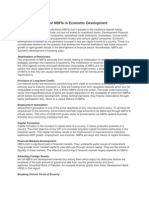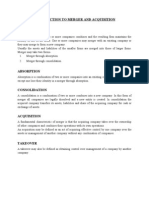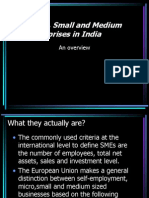Role of SME
Role of SME
Uploaded by
Adr HRCopyright:
Available Formats
Role of SME
Role of SME
Uploaded by
Adr HRCopyright
Available Formats
Share this document
Did you find this document useful?
Is this content inappropriate?
Copyright:
Available Formats
Role of SME
Role of SME
Uploaded by
Adr HRCopyright:
Available Formats
Role of SMEs in Economic Growth of India
Introduction
Small and medium enterprises are the backbone of industrial development.
It is very important for both developed and developing country Small and medium enterprises always
represented the model of economic development, which emphasized high contribution to domestic
production, significant export earnings, low investment requirements, employment generation,
effective contribution to foreign exchange earning of the nation with low import-intensive operations.
The development of this sector came about primarily due to the vision of our late Prime Minister
Jawaharlal Nehru who sought to develop core industry and have a supporting sector in the form of
small scale enterprises.
SMEs sector has emerged as a dynamic and vibrant sector of the economy. The Indian economy is
expected to grow by over 8 per cent per annum until 2020 and can become the second largest in the
world, ahead of the United States, by 2050, and the third largest after China and the United States by
2032.
Definition of MSME
According to new THE MICRO, SMALL AND MEDIUM ENTERPRISES DEVELOPMENT ACT, 2006 the
MSME Definitions are as follows: In the case of the enterprises engaged in the manufacture or
production of goods pertaining to any industry specified in the first schedule to the Industries
(Development and Regulation) Act, 1951, as
Some of the important organizations that are associated with SMEs in India are: Small Industries
Development Organization (SIDO), National Small Industries Corporation Ltd. (NSIC), Small Industries
Development Bank of India (SIDBI), Confederation of Indian Industry (CII), Laghu Udyog Bharti (LUB),
Federation of Indian Chamber of Commerce and Industry (FICCI), Associated Chamber of Commerce and
Industry of India (ASSOCHAM), National Institute of Small-Industry Extension Training (NISIET), World
Association for Small and Medium Enterprises (WASME), Small Scale Industries Board (SSIB), PHD
Chamber of Commerce and Industry (PHDCCI), Federation of Indian Exporters Organization (FIEO),
Federation of Associations of Small Industries of India (FASII)
What they actually are?
The commonly used criteria at the international level to define SMEs are the number of employees,
total net assets, sales and investment level.
The European Union makes a general distinction between self-employment, micro,small and medium
sized businesses based on the following criteria:
And the criteria is-
0 Self-employed
2-9 Micro business
10-49 Small business
50-249 Medium-size business
Criteria in India-
Micro enterprise-investment does not exceed 25 lakh rupees.
Medium enterprise- more than five crores but not upto ten crores.
Small enterprise- more than 25 lakhs rupees but doe not exceed 5 crores.
In case of services-
a micro enterprise- not upto 10 lakh rupees.
a small enterprise- more than 10 lakh but not upto 2 crore rupees.
a medium enterprise- more than 2 crores but not upto 5 crores.
Role of SMEs in Indian Economy
In order understand the impact of SMEs on the Indian economy; one must study the trend and pattern
that have been prevalent in the preceding years. It gives us the vivid picture of what follows next.
Following graphics help us to understand the present scenario and their contributions of MSMEs in
India.
Limitations of the study
The time period given for study was very limited
The respondents of the questionnaire were very busy and could not afford more time to
answer. The average time to response was 5-6 minutes only.
Study restricted through social sites .
MSMEs share by sector
Growth Performance of SMEs or MSMEs in India
Employment in MSME Sector
Sector wise MSME
Activity wise MSME
The opportunities of growth in the SMEs sector
Less Capital Intensive
Extensive Promotion & Support by Government
Reservation for Exclusive Manufacture by small scale sector
Project Profiles
Funding - Finance & Subsidies
Machinery Procurement
Raw Material Procurement
Manpower Training
Technical & Managerial skills
Tooling & Testing support
Reservation for Exclusive Purchase by Government
Export Promotion
Growth in demand in the domestic market size due to overall economic growth
Increasing Export Potential for Indian products
Factors affecting SMEs
MSMEs in India face several problems such as-
1. lack of availability of adequate and timely credit
2. High cost of credit
3. inadequate infrastructure facilities like power, water and roads, and lack of access to modern
technology.
4. limited access to equity capital
5. problems in supply to government departments and agencies
6. procurement of raw materials at a competitive price
7. Issues of storage
8. Designing, packaging and product display
Conclusion
In India SMEs has achieved steady growth over the last couple of years. The role of SMEs in the
industrial sector is growing rapidly and they have become a thrust area for future growth. The Indian
market is growing and the Indian industry is making rapid progress in various Industries like
manufacturing, food processing, textile and garments, retail, precision engineering, information
technology, pharmaceuticals, agro and service sectors. Under the changing economic scenario the SMEs
have both the opportunities and challenges before them.
References:
o http://igovernment.in/site/india-to-develop-1150-sme-clusters
o www.oecd.org/dataoecd/37/47/34026603.pdf
o http://ec.europa.eu
o http://www.businessworld.in/bw/
2009_08_01_The_SME_Whitebook_20092010.html
o http://blog.optionsindia.com/2008/06/sme-sector-in-india-and-random-
thoughts.htm
You might also like
- Leifer Chapter 08 Study Guide Answer KeyDocument5 pagesLeifer Chapter 08 Study Guide Answer KeyTyler Finkle81% (21)
- Jesús Molina Masterclass BookletDocument125 pagesJesús Molina Masterclass BookletShi Zekun88% (8)
- Discount and Finance House of IndiaDocument25 pagesDiscount and Finance House of Indiavikram_bansal_5No ratings yet
- BBA FMI Unit 1 - NoDocument31 pagesBBA FMI Unit 1 - NoRuhani AroraNo ratings yet
- Capital Market IntermediariesDocument15 pagesCapital Market IntermediariesSebin SebastianNo ratings yet
- ICICI Prudential Life Insurance Project Report InternshipDocument26 pagesICICI Prudential Life Insurance Project Report InternshipJeevan Nagendra KattaNo ratings yet
- Innovative Financial ServicesDocument9 pagesInnovative Financial ServicesShubham GuptaNo ratings yet
- Industrial LicensingDocument26 pagesIndustrial LicensingJuiÇý ßitëNo ratings yet
- Financial Management NotesDocument43 pagesFinancial Management Notes15fifteen00No ratings yet
- Idbi Objectives and Functions of IDBI ObjectivesDocument2 pagesIdbi Objectives and Functions of IDBI ObjectivesRohit Pandey0% (1)
- Income Tax Part 1Document128 pagesIncome Tax Part 1Amandeep Kaur SethiNo ratings yet
- Bank and NBFC Mehal PDFDocument38 pagesBank and NBFC Mehal PDFPrasun AgarwalNo ratings yet
- Small Industries Development Bank of India (SIDBI)Document6 pagesSmall Industries Development Bank of India (SIDBI)AnshNo ratings yet
- 53177137-Securitization-Ppt 1Document23 pages53177137-Securitization-Ppt 1kimmiahujaNo ratings yet
- Financial Statements of Banking CompaniesDocument122 pagesFinancial Statements of Banking CompaniesBiswajit PaulNo ratings yet
- Keyman InsuranceDocument4 pagesKeyman InsuranceAnonymous gCE3zvINo ratings yet
- Types of Account HolderDocument23 pagesTypes of Account HolderneemNo ratings yet
- Indian Depository ReceiptsDocument11 pagesIndian Depository ReceiptsZoheb SayaniNo ratings yet
- Managerial Economics - A Decision Science andDocument5 pagesManagerial Economics - A Decision Science andSam NietNo ratings yet
- Merchant BankingDocument26 pagesMerchant BankingSanjay PareekNo ratings yet
- Stock Market - Barometer of The EconomyDocument12 pagesStock Market - Barometer of The Economysmithusdesai9739No ratings yet
- Edp NotesDocument32 pagesEdp NotesAshwini VenugopalNo ratings yet
- Role of NBFIs in Economic DevelopmentDocument2 pagesRole of NBFIs in Economic DevelopmentFaizan ChNo ratings yet
- Predicting Financial Distress of Pharmaceutical Companies in India Using Altman Z Score ModelDocument4 pagesPredicting Financial Distress of Pharmaceutical Companies in India Using Altman Z Score ModelInternational Journal of Innovative Science and Research TechnologyNo ratings yet
- Mergers and AcquisitionsDocument33 pagesMergers and AcquisitionsjinenNo ratings yet
- Asset Reconstruction CompanyDocument32 pagesAsset Reconstruction Companymalayp_20% (1)
- Credit Control in India - WikipediaDocument20 pagesCredit Control in India - WikipediapranjaliNo ratings yet
- History of IDBIDocument43 pagesHistory of IDBIanuragchandrajhaNo ratings yet
- BFSM Unit IDocument30 pagesBFSM Unit IAbhinayaa SNo ratings yet
- Unit III-Leasing and Hire PurchaseDocument50 pagesUnit III-Leasing and Hire PurchaseAkashik GgNo ratings yet
- Question: What Are The Functional Areas Of: Financial Management?Document3 pagesQuestion: What Are The Functional Areas Of: Financial Management?Madhubala SinghNo ratings yet
- AdrDocument10 pagesAdrvahid100% (2)
- SidbiDocument3 pagesSidbiPaavni SharmaNo ratings yet
- Sip CotDocument8 pagesSip CotyogeshNo ratings yet
- Effects of Foreign Exchange Rates On Indian EconomyDocument43 pagesEffects of Foreign Exchange Rates On Indian EconomyMohamed Rizwan0% (1)
- M&a in Indian BanksDocument48 pagesM&a in Indian Banksvikas_kumar820No ratings yet
- MBA-Nayak PPT 1Document15 pagesMBA-Nayak PPT 1Anveshak PardhiNo ratings yet
- SIDCDocument37 pagesSIDCRAJESH VNo ratings yet
- Ifim Unit 1 - NotesDocument17 pagesIfim Unit 1 - NotesJyot DhamiNo ratings yet
- Presentation - On - Companies - Act2013 - K C MehtaDocument116 pagesPresentation - On - Companies - Act2013 - K C MehtasarashviNo ratings yet
- Factoring and ForfaitingDocument34 pagesFactoring and ForfaitingStone HsuNo ratings yet
- CH 3 Institutional Support To International BusinessDocument77 pagesCH 3 Institutional Support To International Businessgouthamireddy75No ratings yet
- Unit - 2 Legal Aspects of BusinessDocument20 pagesUnit - 2 Legal Aspects of BusinessmailtomanicksgmailcoNo ratings yet
- Tandon Committee Report On Working CapitalDocument4 pagesTandon Committee Report On Working CapitalMohitAhuja100% (1)
- SBI & BMB MergerDocument12 pagesSBI & BMB MergerShubham naharwal (PGDM 17-19)No ratings yet
- Business EnvironmentDocument1 pageBusiness Environmentnani66215487No ratings yet
- Debt Market in IndiaDocument5 pagesDebt Market in IndiaBasavaraju K R100% (1)
- Role of IfciDocument10 pagesRole of IfciAditi GandhiNo ratings yet
- Topic:-Clubbing of Incomes and Aggregation of IncomesDocument31 pagesTopic:-Clubbing of Incomes and Aggregation of IncomesmaanikyanNo ratings yet
- Internal Reconstruction of A CompanyDocument12 pagesInternal Reconstruction of A CompanyTina SharmaNo ratings yet
- DTP Full NotesDocument114 pagesDTP Full NotesCHAITHRANo ratings yet
- Investigation into the Adherence to Corporate Governance in Zimbabwe’s SME SectorFrom EverandInvestigation into the Adherence to Corporate Governance in Zimbabwe’s SME SectorNo ratings yet
- GST Tally ERP9 English: A Handbook for Understanding GST Implementation in TallyFrom EverandGST Tally ERP9 English: A Handbook for Understanding GST Implementation in TallyRating: 5 out of 5 stars5/5 (1)
- Thesis. Final FileDocument25 pagesThesis. Final FileSoumitree MazumderNo ratings yet
- M.Phil Thesis Final On CREDIT FACILITIES FOR SME's by PUTTU GURU PRASADDocument148 pagesM.Phil Thesis Final On CREDIT FACILITIES FOR SME's by PUTTU GURU PRASADPUTTU GURU PRASAD SENGUNTHA MUDALIAR100% (10)
- 16 Role of SME in Indian Economoy - Ruchika - FINC004Document22 pages16 Role of SME in Indian Economoy - Ruchika - FINC004Ajeet SinghNo ratings yet
- MSME Issues and Challenges 1Document7 pagesMSME Issues and Challenges 1Rashmi Ranjan PanigrahiNo ratings yet
- Key Words: Small Scale Industry, Economic DevelopmentDocument15 pagesKey Words: Small Scale Industry, Economic DevelopmentBibinNo ratings yet
- English Assignment 1Document30 pagesEnglish Assignment 1Satyapriya PangiNo ratings yet
- Chapter No. Name of The Concept NoDocument1 pageChapter No. Name of The Concept NoAdr HRNo ratings yet
- Data Analysis and InterpretationDocument28 pagesData Analysis and InterpretationAdr HRNo ratings yet
- Creating Competitive Smes in India: Presented By: Dhariti Walia (10810021) Saryu Kamra (10810056) Yuki Jain (10810074)Document27 pagesCreating Competitive Smes in India: Presented By: Dhariti Walia (10810021) Saryu Kamra (10810056) Yuki Jain (10810074)Adr HRNo ratings yet
- QuestionsDocument5 pagesQuestionsAdr HRNo ratings yet
- Micro, Small and Medium Enterprises in India: An OverviewDocument23 pagesMicro, Small and Medium Enterprises in India: An OverviewAdr HRNo ratings yet
- ReferencesDocument1 pageReferencesAdr HRNo ratings yet
- Questionnaire Recruitment: Name of The Employee: Designation: Experience: DepartmentDocument2 pagesQuestionnaire Recruitment: Name of The Employee: Designation: Experience: DepartmentAdr HRNo ratings yet
- Chapter 3-Company ProfileDocument7 pagesChapter 3-Company ProfileAdr HRNo ratings yet
- Trojan BackdoorsDocument32 pagesTrojan BackdoorsSneha VermaNo ratings yet
- Nopti ArabeDocument75 pagesNopti ArabeanaNo ratings yet
- Everyday ActivitiesDocument1 pageEveryday ActivitiesAnnaNo ratings yet
- EDN612 ESN212 EPN210 Installation GuideDocument28 pagesEDN612 ESN212 EPN210 Installation GuideOnofreNo ratings yet
- Discourse Analysis: Assist. Prof. Muhsin YanarDocument23 pagesDiscourse Analysis: Assist. Prof. Muhsin YanarDudu Nur DemirNo ratings yet
- Whittington Et Al., 2020 - CSRDocument8 pagesWhittington Et Al., 2020 - CSRGabriele KaubryteNo ratings yet
- LogDocument30 pagesLogKristof SavskiNo ratings yet
- Andre Bagus Irshanto Magister Pendidikan Sejarah, Universitas Pendidikan IndonesiaDocument14 pagesAndre Bagus Irshanto Magister Pendidikan Sejarah, Universitas Pendidikan IndonesiaTegar Ardeta tegarardeta.2019No ratings yet
- Isotopes - Principles and Applications FaureDocument18 pagesIsotopes - Principles and Applications FaureMarco Helenio CoelhoNo ratings yet
- IELTS Prediction 0624Document24 pagesIELTS Prediction 0624premrajbanshi5533No ratings yet
- Margaret Neilson Armstrong: Botanica CollectedDocument1 pageMargaret Neilson Armstrong: Botanica CollectedJuan Pablo RuanoNo ratings yet
- Sociology For Business (SOC-201) : Bba 5 SemesterDocument87 pagesSociology For Business (SOC-201) : Bba 5 SemesterRajan SubediNo ratings yet
- Magic Quadrant For Blade ServersDocument10 pagesMagic Quadrant For Blade ServerslbedregalNo ratings yet
- Soil Science Soc of Amer J - 2014 - Olson - Experimental Consideration Treatments and Methods in Determining Soil OrganicDocument14 pagesSoil Science Soc of Amer J - 2014 - Olson - Experimental Consideration Treatments and Methods in Determining Soil OrganicJoão Vitor Silva OliveiraNo ratings yet
- BLL 111 - 2-10-2023 - Langkit PDFDocument6 pagesBLL 111 - 2-10-2023 - Langkit PDFnpqzjxyn9kNo ratings yet
- NDJ Sprinklers EngDocument40 pagesNDJ Sprinklers EngsanitermNo ratings yet
- Admit Card2023Document2 pagesAdmit Card2023Anikate SharmaNo ratings yet
- Ficha Interactiva de Future Tenses para PRE-INTERMEDIATEDocument1 pageFicha Interactiva de Future Tenses para PRE-INTERMEDIATEPaul MoranteNo ratings yet
- PHYSICS - Work, Energy, Power, and MomentumDocument45 pagesPHYSICS - Work, Energy, Power, and MomentumFor SchoolNo ratings yet
- Vanilla Sfe Extract Safety Data Sheet: 1. IdentificationDocument8 pagesVanilla Sfe Extract Safety Data Sheet: 1. Identificationfransisco30No ratings yet
- "When I Use A Word," Humpty Dumpty Said, in Rather A Scornful Tone, "It Means Just What I Choose It To Mean-Neither More Nor Less."Document4 pages"When I Use A Word," Humpty Dumpty Said, in Rather A Scornful Tone, "It Means Just What I Choose It To Mean-Neither More Nor Less."jessicaNo ratings yet
- Personal Assessment 3: Capture Your "Journey": HOW HAS CFE 106A Journey With You This Semester? (ImpactDocument2 pagesPersonal Assessment 3: Capture Your "Journey": HOW HAS CFE 106A Journey With You This Semester? (ImpactAldrich Francis Ortiz PeñaflorNo ratings yet
- MeningoencephaloceleDocument13 pagesMeningoencephaloceleIda Bagus Yudha Prasista100% (1)
- 9-17-2018 Full Ben Fulford PDFDocument4 pages9-17-2018 Full Ben Fulford PDFHen RyNo ratings yet
- S 2 SolDocument2 pagesS 2 SolTom DavisNo ratings yet
- Document Type Definition (DTD) : Author: Lukasz KurganDocument19 pagesDocument Type Definition (DTD) : Author: Lukasz Kurganchitra deviNo ratings yet
- Exam: 646-203 Title: Cisco Sales Expert Ver: 06.10.09Document86 pagesExam: 646-203 Title: Cisco Sales Expert Ver: 06.10.09Ovidiu ManolescuNo ratings yet
- Cartography E-Books ListDocument7 pagesCartography E-Books ListAhmad AfandiNo ratings yet

































































































